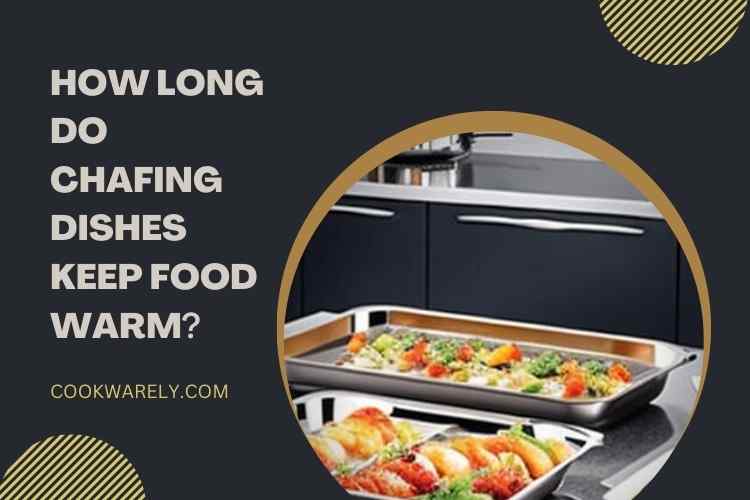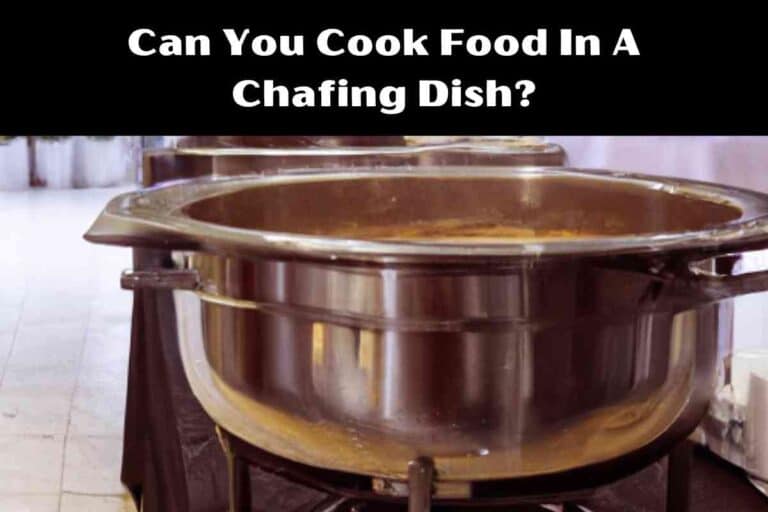Do You Put Water in an Electric Chafing Dish?
Are you unsure whether to add water to your electric chafing dish? This common question has left many hosts scratching their heads.
Yes, you should put water in an electric chafing dish. The water helps to evenly distribute heat and prevent food from burning or sticking to the bottom of the dish. It also helps to keep the food moist and prevent it from drying out. Be sure to check the water level periodically and add more as needed.
In this guide, we’ll explore the answer and provide some helpful tips for using your electric chafing dish.

What is an Electric Chafing Dish?
A buffet server used to keep food heated during events and gatherings is an electric chafing dish. It is a popular option among caterers, event planners, and home cooks who wish to serve hot dishes without continuously reheating them.
Definition
Essentially, an electric chafing dish is a heated tray used to keep food toasty. It includes a metal frame, a heating element, and one or more food-holding containers. The heating element is typically situated beneath the cookware and can be adjusted to maintain the desired food temperature.
Types
There are numerous varieties of electric chafing dishes on the market. Among the most prevalent varieties are:
The most prevalent form of electric chafing dish is the rectangular variety. Typically, they are large enough to hold multiple dishes at once and frequently include multiple pans for holding various forms of food.
These are comparable to rectangular electric chafing dishes, but they are round. They are frequently used to serve soups, stews, and other bowl-appropriate dishes.
These are smaller electric chafing dishes designed to accommodate a single pan of food. They are ideal for serving a solitary dish or for smaller gatherings.
Each variety of electric chafing dish has its own distinctive features and benefits, so it is essential to select the one that best meets your requirements.
How Does an Electric Chafing Dish Work?
A buffet server that uses electricity to heat and sustain the temperature of food is an electric chafing dish. It is a practical and effective method for keeping food heated at parties, events, and gatherings.
There are different components of an electric chafing dish work together to maintain a safe and consistent temperature for food.
Components
These are the primary components of an electric chafing dish:
- A thermal component
- A water dish
- A culinary dish
- A lid
- A thermostatic regulator
The water is heated by a heating element located beneath the water basin. The water container is situated above the heating element and contains water that is heated by the element.
The meal container is positioned above the water container and contains food. The lid is used to keep the food heated by covering it. The thermostat control is used to modulate the heating element’s temperature.
Function
When the electric chafing dish is turned on, the water in the water container is heated by the heating element. As the water heats, the vapor is produced, which rises and heats the pan above it. The vapor prevents the food from drying out by keeping it moist.
The thermostat control is used to adjust the heating element’s temperature, which in turn effects the water and food temperatures. The lid is used to keep the food heated by covering it.
An electric chafing dish eliminates the need for an external heat source, such as a sterno or candle, which is one of its advantages. This makes it safer and more convenient to use, particularly in densely populated areas.
In addition, electric chafing dishes are simple to clean and maintain, as they require neither special fuels nor equipment.
Do You Need to Put Water in an Electric Chafing Dish?
Chafing dishes powered by electricity are a convenient method to keep food warm for extended periods. They are typically employed in catering and buffet contexts.
One of the most frequently asked inquiries regarding the use of an electric chafing dish is whether or not water must be added. There is no straightforward yes or no answer. It depends on the type of cuisine and chafing dish used.
Reasons for Adding Water
Adding water to an electric chafing dish is primarily done to generate vapor. Steam maintains food’s moisture and prevents it from drying out. Additionally, it aids in maintaining a constant temperature.
Typically, water is poured into the bottom of the chafing dish, below the food pan. The food pan is placed atop the water pan to allow steam to ascend and keep the food warm.
Additionally, adding water prevents the food from scorching. Without water, the pan can overheat and cause food to cook. The water serves as a barrier between the food and the heat source, preventing the food from becoming excessively heated.
When Not to Add Water
In certain instances, it may not be necessary to add water to an electric chafing dish. For instance, adding water to dry foods such as bread or wafers is not necessary.
The same principle applies to foods that are already moist, such as soups and stews. In these instances, adding water can make the food too saturated and alter its texture and flavor.
Noting that some electric chafing dishes are designed to be used without water is also essential. Typically, a heating element is incorporated into the base of these vessels.
The food pan rests directly on the heating element, eliminating the need for a separate water pan. Before using an electric chafing dish without water, make sure to consult the manufacturer’s instructions.
How Much Water Should You Add?
To prevent food from drying out when using an electric chafing dish, it is essential to add the appropriate amount of water. Here are some recommendations:
General Rule of Thumb
Add 1 to 2 inches of water to the water basin of your electric chafing dish as a general rule. This should be sufficient to keep your food heated and moist without excessive boiling or evaporation.
However, it is essential to consult the manufacturer’s instructions for your particular chafing dish, as different models may require more or less water.
Adjusting for Different Dishes
Depending on the depth or width of your dish, you may need to adjust the quantity of water added. For instance, if you are using a dish that is deeper, you may need to add more water to ensure that the food reaches the proper temperature and remains heated for longer.
Likewise, if your dish is shallower, you may need to add less water to prevent it from bubbling over or evaporating too rapidly.
Additionally, it is essential to consider the type of cuisine being served. Meats and bread, which are more susceptible to drying out, may require more water to remain hydrated. On the other hand, stews and soups, which are already fluid, may require less water.
The quantity of water you add will ultimately depend on a variety of factors, such as the size and shape of your chafing dish, the type of food you are serving, and the manufacturer’s instructions.
By adhering to these guidelines and using your best judgment, you can ensure that your food remains heated, moist, and tasty.
What Kind of Water Should You Use?
Tap Water
It is not recommended to use municipal water in an electric chafing dish because it may contain impurities and minerals that can affect the dish’s performance.
The minerals in municipal water can cause a buildup in the dish, impairing its heating ability and eventually causing damage. In addition, tap water may contain chlorine or other contaminants that alter the flavor and quality of food.
Filtered Water
Filtered water is preferable to faucet water because it eliminates the impurities and minerals that can hinder the performance of the chafing dish.
It is essential to note, however, that not all filters are created equal, and some may not eliminate all impurities. Utilizing a high-quality filter that removes as many impurities as possible is advised.
Distilled Water
Distilled water is the best option for electric chafing dishes because it is devoid of impurities and minerals that can hinder the dish’s performance.
The creation of distilled water involves boiling water and then capturing the steam, which contains no impurities or minerals. This process eliminates virtually all impurities, resulting in the purest form of water.
It is important to note that other types of water, such as spring water or mineral water, should not be used with chafing dishes because they may contain minerals that impact their performance.






